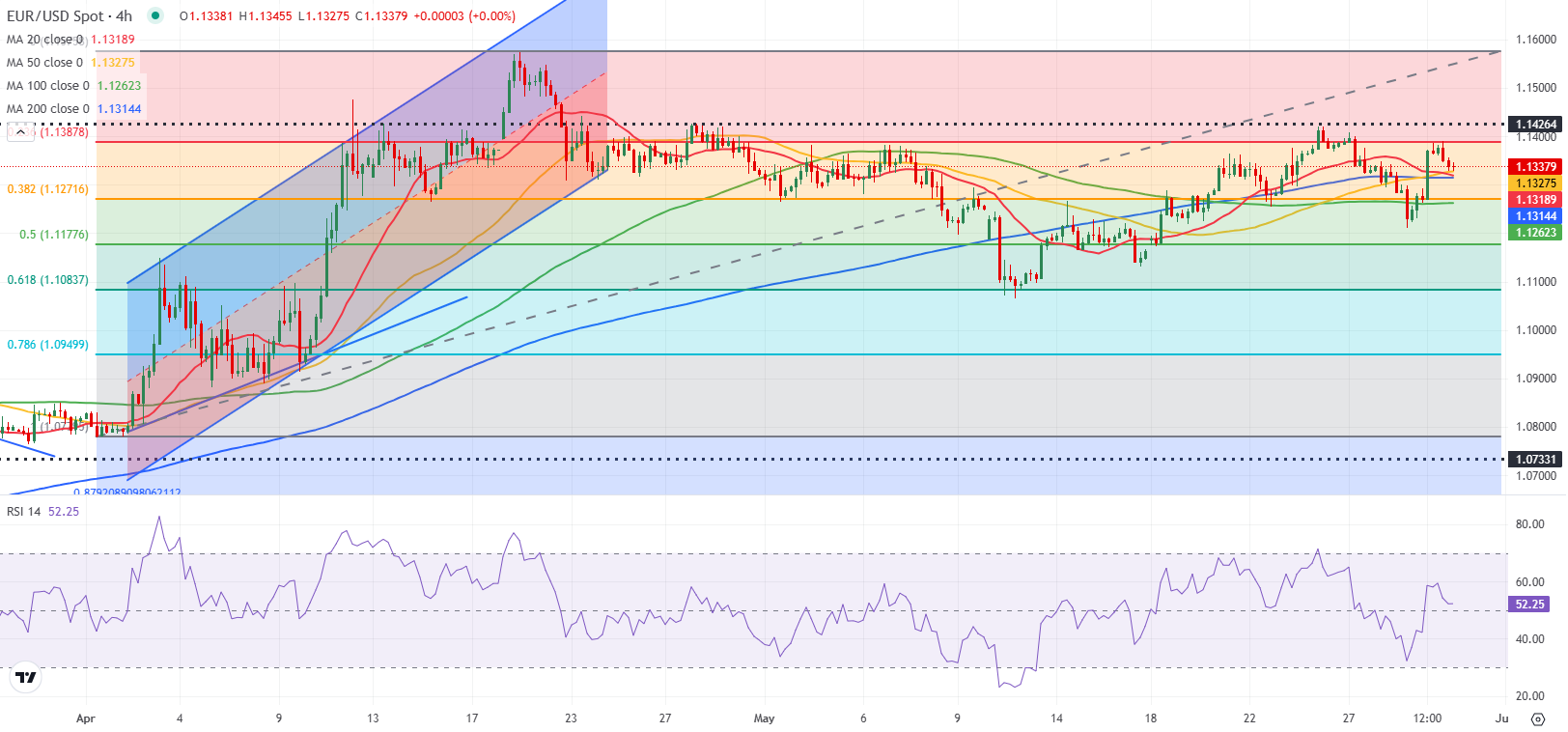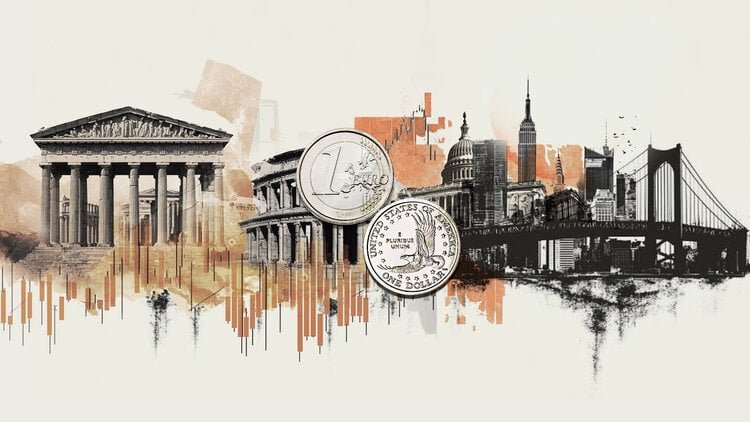- EUR/USD finds it difficult to build on Thursday’s gains, holds above 1.1300.
- Markets await April PCE inflation data from the US.
- The technical outlook points to a lack of directional momentum.
Following the bearish action seen in the first half of the day on Thursday, EUR/USD regained its traction in the American session and closed the day in positive territory. The pair stays on the back foot early Friday and trades below 1.1350 ahead of key inflation data from the US.
Euro PRICE This week
The table below shows the percentage change of Euro (EUR) against listed major currencies this week. Euro was the weakest against the US Dollar.
| USD | EUR | GBP | JPY | CAD | AUD | NZD | CHF | |
|---|---|---|---|---|---|---|---|---|
| USD | 0.28% | 0.38% | 1.05% | 0.61% | 1.13% | 0.54% | 0.35% | |
| EUR | -0.28% | 0.12% | 0.85% | 0.33% | 0.85% | 0.27% | 0.09% | |
| GBP | -0.38% | -0.12% | 0.39% | 0.21% | 0.73% | 0.14% | -0.01% | |
| JPY | -1.05% | -0.85% | -0.39% | -0.44% | 0.06% | -0.56% | -0.70% | |
| CAD | -0.61% | -0.33% | -0.21% | 0.44% | 0.53% | -0.06% | -0.23% | |
| AUD | -1.13% | -0.85% | -0.73% | -0.06% | -0.53% | -0.61% | -0.75% | |
| NZD | -0.54% | -0.27% | -0.14% | 0.56% | 0.06% | 0.61% | -0.17% | |
| CHF | -0.35% | -0.09% | 0.01% | 0.70% | 0.23% | 0.75% | 0.17% |
The heat map shows percentage changes of major currencies against each other. The base currency is picked from the left column, while the quote currency is picked from the top row. For example, if you pick the Euro from the left column and move along the horizontal line to the US Dollar, the percentage change displayed in the box will represent EUR (base)/USD (quote).
The US Dollar (USD) came under renewed selling pressure late Thursday and helped EUR/USD push higher. The data published by the US Department of Labor showed that there were 240,000 first-time applications for unemployment benefits in the week ending May 24, compared to the market expectation of 226,00.
Additionally, the Court of Appeals for the Federal Circuit’s decision to reinstate US President Donald Trump’s tariffs, which were blocked by the Court of International Trade on Wednesday, during the review process of the appeal weighed on the USD.
The US Bureau of Economic Analysis will publish the Personal Consumption Expenditures (PCE) Price Index data, the Federal Reserve’s preferred gauge of inflation, for April later in the day.
Markets expect the core PCE Price Index to rise by 0.1% on a monthly basis in April after remaining unchanged in March. A reading of 0.3%, or higher, could boost the USD with the immediate reaction and cause EUR/USD to stretch lower heading into the weekend. On the other hand, a negative print in this data could trigger a USD selloff.
EUR/USD Technical Analysis

The near-term technical outlook points to a lack of directional momentum, with the Relative Strength Index (RSI) indicator on the 4-hour chart holding slightly above 50. Also, EUR/USD fluctuates at around 1.1330, where the 200-period, 50-period and 20-period Simple Moving Averages (SMA) align.
On the upside, 1.1380 (Fibonacci 23.6% retracement of the latest uptrend) could be seen as the first resistance level before 1.1430 (static level) and 1.1500 (static level, round level). Looking south, supports could be spotted at 1.1270 (100-period SMA, Fibonacci 38.2% retracement), 1.1180 (Fibonacci 50% retracement) and 1.1080 (Fibonacci 61.8% retracement).
Euro FAQs
The Euro is the currency for the 19 European Union countries that belong to the Eurozone. It is the second most heavily traded currency in the world behind the US Dollar. In 2022, it accounted for 31% of all foreign exchange transactions, with an average daily turnover of over $2.2 trillion a day.
EUR/USD is the most heavily traded currency pair in the world, accounting for an estimated 30% off all transactions, followed by EUR/JPY (4%), EUR/GBP (3%) and EUR/AUD (2%).
The European Central Bank (ECB) in Frankfurt, Germany, is the reserve bank for the Eurozone. The ECB sets interest rates and manages monetary policy.
The ECB’s primary mandate is to maintain price stability, which means either controlling inflation or stimulating growth. Its primary tool is the raising or lowering of interest rates. Relatively high interest rates – or the expectation of higher rates – will usually benefit the Euro and vice versa.
The ECB Governing Council makes monetary policy decisions at meetings held eight times a year. Decisions are made by heads of the Eurozone national banks and six permanent members, including the President of the ECB, Christine Lagarde.
Eurozone inflation data, measured by the Harmonized Index of Consumer Prices (HICP), is an important econometric for the Euro. If inflation rises more than expected, especially if above the ECB’s 2% target, it obliges the ECB to raise interest rates to bring it back under control.
Relatively high interest rates compared to its counterparts will usually benefit the Euro, as it makes the region more attractive as a place for global investors to park their money.
Data releases gauge the health of the economy and can impact on the Euro. Indicators such as GDP, Manufacturing and Services PMIs, employment, and consumer sentiment surveys can all influence the direction of the single currency.
A strong economy is good for the Euro. Not only does it attract more foreign investment but it may encourage the ECB to put up interest rates, which will directly strengthen the Euro. Otherwise, if economic data is weak, the Euro is likely to fall.
Economic data for the four largest economies in the euro area (Germany, France, Italy and Spain) are especially significant, as they account for 75% of the Eurozone’s economy.
Another significant data release for the Euro is the Trade Balance. This indicator measures the difference between what a country earns from its exports and what it spends on imports over a given period.
If a country produces highly sought after exports then its currency will gain in value purely from the extra demand created from foreign buyers seeking to purchase these goods. Therefore, a positive net Trade Balance strengthens a currency and vice versa for a negative balance.

